In the bustling world of the casino industry, Landmark Casino was once a towering figure, known for its opulence, grandeur, and unparalleled entertainment offerings. Situated in the heart of Las Vegas, Landmark Casino rose to prominence during the 1960s and 1970s, attracting high-rollers, celebrities, and tourists from around the globe. However, like many icons of its time, Landmark Casino eventually faced a decline that led to its ultimate demise. In this retrospective, we will explore the rise and fall of 랜드마크카지노, examining the factors that contributed to its success and the challenges that ultimately led to its downfall.
The Rise of Landmark Casino
Landmark Casino opened its doors to the public in 1969, during a period of unprecedented growth and development in Las Vegas. Boasting a prime location on the famous Las Vegas Strip, Landmark Casino quickly became known for its lavish amenities, world-class entertainment, and unmatched gaming experience. The casino’s sleek modern design, featuring a distinctive tower and neon-lit facade, captured the imagination of visitors and set it apart from its competitors.
One of the key factors behind Landmark Casino’s success was its innovative approach to gaming. Unlike traditional casinos of the time, which primarily focused on gambling, Landmark Casino offered a diverse range of entertainment options, including live performances by top-tier artists, extravagant stage shows, and gourmet dining experiences. This multifaceted approach attracted a diverse clientele and helped establish Landmark Casino as a premier destination for entertainment seekers.
Additionally, Landmark Casino was renowned for its luxurious accommodations, with spacious rooms, elegant decor, and panoramic views of the Las Vegas skyline. The casino’s hotel became a popular choice for affluent travelers and high-rollers, further cementing its reputation as a symbol of luxury and sophistication.
Throughout the 1970s, Landmark Casino continued to thrive, drawing in crowds with its glitzy atmosphere, celebrity sightings, and high-stakes gaming action. The casino’s success seemed unstoppable, as it enjoyed record profits and expanded its footprint on the Las Vegas Strip.
The Fall of Landmark Casino
Despite its initial success, Landmark Casino began to face challenges in the 1980s that would ultimately lead to its downfall. One of the primary factors was increased competition from newer, more extravagant casinos that were opening up across Las Vegas. These mega-resorts, such as the Mirage and the MGM Grand, offered larger gaming floors, more luxurious accommodations, and a wider range of entertainment options, posing a direct threat to 랜드마크카지노쿠폰 market share.
Furthermore, changes in consumer preferences and gambling trends also contributed to Landmark Casino’s decline. As the casino industry evolved, with the rise of destination resorts and themed attractions, Landmark Casino struggled to keep pace with changing tastes and demands. The casino’s once-innovative offerings began to feel outdated compared to the newer, more immersive experiences being offered elsewhere on the Strip.
Financial difficulties further exacerbated Landmark Casino’s troubles, as mounting debts and declining revenues put a strain on the casino’s operations. Despite attempts to attract investment and revitalize the property, Landmark Casino was unable to reverse its fortunes and ultimately filed for bankruptcy in 1990.
The closure of Landmark Casino marked the end of an era in Las Vegas, as one of the city’s most iconic landmarks was lost to history. The property was eventually sold to new owners, who demolished the original building and replaced it with a new development. Today, the site of Landmark Casino is home to a modern hotel and casino complex, serving as a reminder of the ever-changing nature of the Las Vegas Strip.
Lessons Learned
The rise and fall of Landmark Casino offer valuable lessons for the casino industry as a whole. The casino’s initial success was built on a combination of innovative offerings, luxurious amenities, and strategic positioning. However, as competition intensified and consumer preferences shifted, Landmark Casino struggled to adapt and ultimately fell behind its rivals.
In hindsight, the story of Landmark Casino serves as a cautionary tale about the importance of staying ahead of the curve in a rapidly evolving industry. To succeed in the highly competitive world of gaming and entertainment, casinos must continually innovate, invest in new technologies, and anticipate changing consumer trends. Failure to do so can lead to obsolescence and ultimately, the downfall of even the most iconic establishments.
Conclusion
The rise and fall of Landmark Casino are a testament to the ever-changing nature of the casino industry and the challenges faced by even the most successful establishments. From its humble beginnings as a towering symbol of luxury and sophistication to its eventual demise in the face of increased competition and changing consumer preferences, Landmark Casino’s story is a reminder of the importance of adaptability and innovation in a constantly evolving market.
While Landmark Casino may have faded into history, its legacy lives on in the memories of those who visited its hallowed halls and experienced the excitement of its golden era. As Las Vegas continues to reinvent itself and push the boundaries of entertainment, the lessons learned from Landmark Casino’s rise and fall will serve as a guiding light for future generations of casino operators and industry stakeholders.






